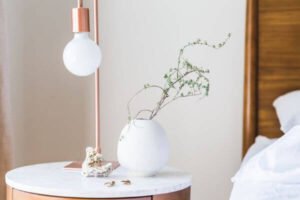In the ever-evolving world of interior design, the pursuit of optimizing spaces has become a crucial aspect of creating functional and visually appealing environments. This article delves deeper into the concept of “360-Degree Optimization,” exploring strategies to fill every nook of a space with purpose, ensuring a holistic and comprehensive approach to interior design. From reimagining overlooked spaces to the utilization of modular furniture and the magic of built-in elements, discover how to transform every corner into a valuable and purposeful component of your living space.
1. Reassessing Overlooked Spaces: A Canvas for Innovation
The journey of 360-degree optimization begins with a meticulous reassessment of spaces often overlooked or neglected. These forgotten corners, alcoves, and areas beneath stairs present opportunities for innovation and creative solutions. By considering each centimeter as a canvas for design ingenuity, we unveil hidden potentials that can significantly enhance both the functionality and aesthetics of a room.
Creative Idea: Introduce floating shelves into an underutilized corner of your living room, creating a unique focal point for displaying small plants, books, or decorative items.
2. Modular Furniture: Adapting to Unique Angles
The strategic use of modular furniture emerges as a cornerstone in the optimization of spaces with challenging angles and irregular dimensions. These adaptable furnishings offer a versatile solution, efficiently filling gaps and providing customized arrangements tailored to specific spatial challenges. Beyond maximizing square footage, modular pieces contribute a dynamic and flexible dimension to the overall design.
Creative Idea: Select a modular sofa that effortlessly adjusts to the contours of an angular space, offering comfortable seating without compromising the layout of the room.
3. The Magic of Built-In Elements: Seamlessly Integrated Solutions
Built-in furniture proves to be a transformative element in optimizing small spaces by seamlessly integrating with the architectural framework. Cabinets, bookshelves, and custom countertops, designed to fit within the existing structure, leverage every available inch. This not only eliminates the need for bulky furnishings but imparts a sense of unity and order to the room.
Creative Idea: Design a built-in bookshelf on a wall to create a personalized library, maximizing storage without compromising available space.
4. Transforming Nooks into Functional Retreats
Nooks, often overlooked and underutilized, can be transformed into functional and aesthetically pleasing retreats. Incorporating built-in seating, comfortable cushions, and purposeful lighting can convert these spaces into cozy reading nooks or decorative alcoves. This approach not only optimizes the environment but infuses charm and personality into the space.
Creative Idea: Convert an underused space beneath a window into a cozy bench with cushions and built-in shelves, creating an inviting reading nook.
5. Vertical Organization: Expanding Horizons
In the pursuit of space optimization, a crucial strategy involves thinking vertically. Utilizing shelves, hanging cabinets, and wall organizers maximizes vertical space, freeing up the floor for a more open and spacious feel. This approach not only provides practical storage solutions but also contributes to the visual expansiveness of the environment.
Creative Idea: Install floating shelves on the kitchen wall to store utensils, saving space in cabinets and adding a decorative touch.
6. Strategies for Low Ceiling Corners: Creating Illusions
Spaces with low ceilings present unique challenges, requiring specific strategies for optimization. Opting for furniture with vertical lines creates the illusion of height, while light colors and directed lighting maintain an airy atmosphere. Avoiding bulky furniture is crucial to preventing a sense of claustrophobia in such environments.
Creative Idea: Hang floor-to-ceiling curtains to create the illusion of higher ceilings, adding a feeling of expansiveness to the space.
7. Adding Personality to Every Space: Infusing Character
While optimizing every nook for functionality, it’s equally important to infuse each space with elements that reflect the occupant’s personality. Thoughtful details, such as art, plants, or meaningful decorative items, not only fill the spaces but also create a more welcoming and personalized environment.
Creative Idea: Curate a gallery wall in a narrow hallway, showcasing photographs, art, and memorabilia that tell the unique story of the occupant.
8. Smart Storage Solutions: Concealed and Stylish
In the quest for optimization, integrating smart storage solutions becomes paramount. Concealed storage, such as ottomans with hidden compartments or sleek wall-mounted cabinets, adds functionality without sacrificing style. These solutions not only declutter the space but also contribute to a seamless and sophisticated aesthetic.
Creative Idea: Invest in a stylish storage ottoman for the living room, providing a chic seating option with concealed storage for blankets, magazines, or other items.
9. Lighting Techniques: Illuminating Every Corner
Strategic lighting plays a crucial role in optimizing spaces, especially in areas that may be naturally darker or overlooked. Use a combination of ambient, task, and accent lighting to illuminate every nook effectively. Well-placed lighting not only enhances visibility but also adds a layer of ambiance to different corners.
Creative Idea: Install LED strip lights under floating shelves to create an inviting ambiance while highlighting decorative items or books.
Conclusion: A Holistic Approach to Design
In the pursuit of creating harmonious and efficient living spaces, the 360-degree optimization approach stands as a testament to a holistic design philosophy. By filling every nook with purpose, we transcend the conventional boundaries of interior design, transforming seemingly small spaces into functional, aesthetically pleasing, and truly personalized environments. Embrace these strategies in your own home, unlock the hidden potential of every corner, and witness the magic of optimization that exceeds traditional expectations.

